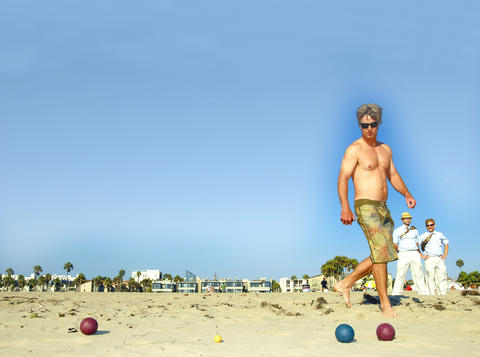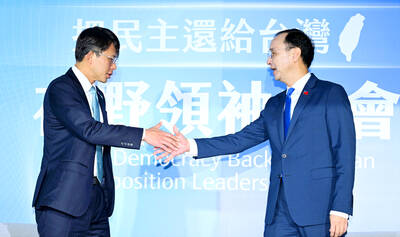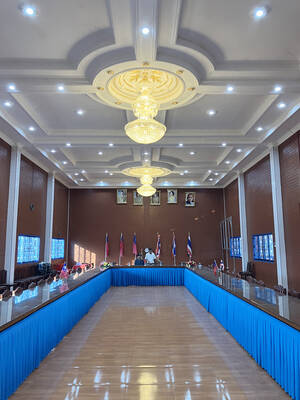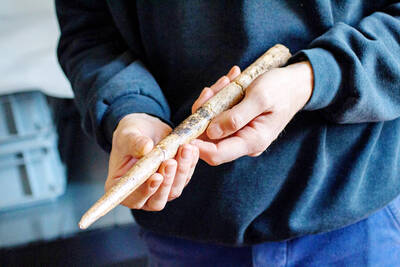The scene on the beach seemed normal for a 26°C day: Children flew kites, while women in leopard-print bikinis sunbathed. But near the edge of the water, a group of young men and women were throwing heavy balls at a smaller one stuck in the sand.
It was the third annual Beach Bocce Ball League championship tournament, and the Big Bambini, a two-man team made up of Dominic Bernacchi and Adam Svatek, was struggling during a tight match.
Svatek had tossed what a bystander called "the ultimate first throw," his ball landing directly in front of his target, but the opposing team, Bocce Bocce and Sons, managed to knock it away. And when Bocce Bocce and Sons blocked out the barrage of insults and trash talking by listening to Enya on their iPods, it made matters even more challenging.

PHOTO: NY TIMES NEWS SERVICE
"This is not fun," said Bernacchi, 31, as he tightened the drawstring on his brown sweat pants. "We can't talk to them."
But like a latter-day Michael Jordan (if Michael Jordan made his living casually tossing small plastic balls on sandy beaches), Bernacchi came through in the clutch. After drinking a beer that belonged to his rivals, he waved the empty bottle in front of them saying, "Will you get me another?" Bocce Bocce was so rattled that it missed its final throws.
Big Bambini won, 11-9.

PHOTO: NY TIMES NEWS SERVICES
Bocce, pronounced BAH-chee, the genteel Italian sport once played exclusively by leathery men in alabaster outfits on courts made of crushed seashells, has been adopted by young professionals.
"Those old guys were wicked experienced," said Tim Jacobs, 31, who works in advertising and founded the league three years ago with Bernacchi, who also works in advertising. "They had a wine buzz. They had a cigar. They were relaxing. Why should a 30-year-old not be able to relax like that?"
One hundred men and women, most of whom work in the advertising industry, play in the Los Angeles chapter of the Beach Bocce Ball League, and 50 more participate in the Chicago branch, which Jacobs started this year after moving from Los Angeles. Elsewhere, the DC Bocce League in Washington DC, which is four years old, meets on the grass at Garfield Park and is so popular that the 300 available slots were filled in 15 minutes.
Although bocce's rules (and its spelling) can vary, basically each of the two teams get four balls weighing about 1.3kg each, which are rolled or tossed at a smaller target ball called a pallino. A team scores points for each ball it gets closer to the pallino than its opponent.
The early Romans were among the first to play the game as it exists today, though the French and the British have similar games. Thus bocce is especially ingrained in Italian culture. In the 1950s, for instance, certain models of Fiat automobiles came with a bocce set in the trunk.
Today, most people in their 20s and 30s don't flock to bocce the way they do to sports like Ultimate Frisbee or dodge ball.
"The game still has this image problem," said Mario Pagnoni, 59, the author of The Joy of Bocce. "People think it's old Italians with a cigar and a glass of wine, and it is that to a certain extent. But it's changing. We're a couple of years away from the mainstream."
Bernacchi agreed that younger players were not necessarily interested in a sport that is most commonly associated with retirees. "The fun of it has been that juxtaposition," he said. "With our attitude we try to make it feel youthful and engaging. It's an old man's sport, but it's being played by people in T-shirts with skulls on them."
Bernacchi and Jacobs decided to form their league three years ago on Venice Beach, while sharing a twelve-pack of Pabst Blue Ribbon and a game of bocce, mostly as a way to get their friends out on the sand with them. Jacobs learned the game from his father at his grandparents' farm in Lyons, Wisconsin.
The two men are so obsessed with the sport that they once played a grudge match in a patch of poison oak after a 5km trail run in the mountains. "We totally joked about how ambitious it was to form a league," Jacobs said. "In Los Angeles, it's hard to get someone to commit to a 15-minute lunch."
In selling bocce to their friends, they were more pragmatic. "We positioned it as a simple game you could play with one hand while the other was holding a beer tightly," Bernacchi said.
As in bowling, a player doesn't have to be completely focused on the game, which makes bocce ideal for socializing. "No one talks to you in Los Angeles," said Jerry Torgerson, 38, of Bocce Bocce and Sons. "Then you start throwing bocce and you're buddies."
Bocce is also a sport in which some women say they feel comfortable competing against men. Sarah DeLucas, 28, a marketing coordinator at CQ Press, a publishing company, and a founder of the DC League, had previously joined a mixed kickball league when she moved to Washington, but became disenchanted when she found her male competitors to be too aggressive. "There was a lot of screaming from men at girls," she said.
In bocce, DeLucas added: "Those gender lines disappear. You could be the greatest athlete in the world and stink at bocce. It's nice not to have to worry about some guy screaming at a girl, 'I can't believe you didn't catch the ball.'"
The mixed competitions can lead to romantic match-ups at parties after a game. (The name of the game, after all, is derived from the Italian word for "kiss.")
Bernacchi met his girlfriend, Camille Labouchere, 28, through the league. She agreed to go out with him only after he shaved the mustache he had grown during what he called his "Bukowski phase."
"I showed up to practice one day and there he was, clean-shaven and holding his clipboard," she said. "We kissed a week later."
In Venice, the championship match was all about adrenaline. James Moore, 36, and Sean Stortroen, 26, two rookies on Team America, were dressed in camouflage shorts and hats, and did push-ups between throws. Their opponents, Cory Noonan, 36, and Chad Einbinder, 37, were three-year veterans on the Chrispan McNuts team.
It was a lopsided contest from the start. The McNuts' arms were tired; one of the early tosses missed the pallino by about 1.5m.
"Come on, Nuts," Bernacchi shouted from the sideline. "Don't let these boys do it."
But Team America landed toss after toss as close as they could to the pallino. Their fans cheered: "Stunning!" "Gorgeous!" "They're cyborgs!" Soon, the score was 9-0.
In a desperate attempt to salvage a victory, the McNuts moved the match to the hard-packed sand at the edge of the water where, they said, they played better. But even that didn't help. Team America won, 11-4, and was given the league's version of the Stanley Cup: a sand-filled glass boot on which their names would be etched. They raised the trophy in the air and cheered, "Mission accomplished."

Taiwan Power Co (Taipower, 台電) and the New Taipei City Government in May last year agreed to allow the activation of a spent fuel storage facility for the Jinshan Nuclear Power Plant in Shihmen District (石門). The deal ended eleven years of legal wrangling. According to the Taipower announcement, the city government engaged in repeated delays, failing to approve water and soil conservation plans. Taipower said at the time that plans for another dry storage facility for the Guosheng Nuclear Power Plant in New Taipei City’s Wanli District (萬里) remained stuck in legal limbo. Later that year an agreement was reached

What does the Taiwan People’s Party (TPP) in the Huang Kuo-chang (黃國昌) era stand for? What sets it apart from their allies, the Chinese Nationalist Party (KMT)? With some shifts in tone and emphasis, the KMT’s stances have not changed significantly since the late 2000s and the era of former president Ma Ying-jeou (馬英九). The Democratic Progressive Party’s (DPP) current platform formed in the mid-2010s under the guidance of Tsai Ing-wen (蔡英文), and current President William Lai (賴清德) campaigned on continuity. Though their ideological stances may be a bit stale, they have the advantage of being broadly understood by the voters.

In a high-rise office building in Taipei’s government district, the primary agency for maintaining links to Thailand’s 108 Yunnan villages — which are home to a population of around 200,000 descendants of the Chinese Nationalist Party (KMT) armies stranded in Thailand following the Chinese Civil War — is the Overseas Community Affairs Council (OCAC). Established in China in 1926, the OCAC was born of a mandate to support Chinese education, culture and economic development in far flung Chinese diaspora communities, which, especially in southeast Asia, had underwritten the military insurgencies against the Qing Dynasty that led to the founding of

Artifacts found at archeological sites in France and Spain along the Bay of Biscay shoreline show that humans have been crafting tools from whale bones since more than 20,000 years ago, illustrating anew the resourcefulness of prehistoric people. The tools, primarily hunting implements such as projectile points, were fashioned from the bones of at least five species of large whales, the researchers said. Bones from sperm whales were the most abundant, followed by fin whales, gray whales, right or bowhead whales — two species indistinguishable with the analytical method used in the study — and blue whales. With seafaring capabilities by humans